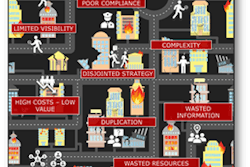
The largest public companies in the United States may have reached the limits of their ability to stretch payables terms with suppliers in mid-2022, as they navigated inventory management in the face of high levels of global uncertainty, according to the Q2 2022 update to the Working Capital Survey performed by The Hackett Group, Inc.
After a slowdown of growth in days payables outstanding (DPO) over the last two quarters, DPO fell by 1.1% (from 56.5 to 55.9 days) in Q2 2022. This indicates a shift of leverage toward sellers, driven by supply chain bottlenecks, inflation pressures and geopolitical risks, among other issues.
“This is the true definition of an inflection point, and a trend that is likely to continue,” says The Hackett Group director Shawn Townsend. “Buyers have become more concerned with supply assurance, and have had to become less prescriptive about how they receive goods and services. In addition, while supply chain financing remains popular, buyers are more focused on using it to stabilize and reinforce the supply base than to extend payment terms.”
From BusinessWire:
- Days inventory outstanding (DIO) remained virtually flat during the period, increasing by just 0.1% (remaining at 46.5 days).
- Days sales outstanding, the third major component of working capital performance, was also largely flat during the period, decreasing by 0.1% (to remain at 40.1 days). These three working capital elements combined to drive a 2% increase in the cash conversion cycle (CCC).
- On the operational side, revenue continued its meteoric rise in Q2, increasing by nearly 20% (4-5 times what was seen pre-pandemic). Cash on hand as a percentage of revenue decreased by almost 30%, and has returned to pre-pandemic levels, signaling that companies are using cash hoarded during the pandemic to pay off debt in anticipation of further interest rate hikes.
“We had seen some atypical improvement in DIO over the past year, which seemed to indicate that companies had built on the lessons learned during the pandemic. But companies are still struggling with a tremendous amount of uncertainty and holding the line on inventory in this environment is actually a big win,” says The Hackett Group director Istvan Bodo.
“Headwinds will clearly continue to persist for the foreseeable future, and discipline, planning and foresight when it comes to working capital management can play a key role in helping companies succeed,” says Townsend. “Inventory management presents one of the biggest conundrums for companies today. It’s critical for companies to ensure they can rapidly recognize and respond to changing demand signals. On receivables, companies should continue to review credit and collections management process, as well as payment terms and contractual milestones. With payables, improving supplier management is key. Supplier criticality, competition for resources, and supply availability may warrant revisiting sourcing, location, and working capital strategies. Contingency planning is also becoming increasingly important, including incorporating risk into cash/cost/service equation.
“This is not the time for companies to take their foot off the gas when it comes to working capital and cash flow management. Smart business leaders will double down on capabilities for managing working capital health – increasing their visibility into key indicators, sharing information better across functions, and automating processes – to enable agility amid continuing change,” adds Townsend.




![Pros To Know 2026 [color]](https://img.sdcexec.com/mindful/acbm/workspaces/default/uploads/2025/08/prostoknow-2026-color.mduFvhpgMk.png?auto=format%2Ccompress&bg=fff&fill-color=fff&fit=fill&h=100&q=70&w=100)







![Pros To Know 2026 [color]](https://img.sdcexec.com/mindful/acbm/workspaces/default/uploads/2025/08/prostoknow-2026-color.mduFvhpgMk.png?ar=16%3A9&auto=format%2Ccompress&bg=fff&fill-color=fff&fit=fill&h=135&q=70&w=240)






